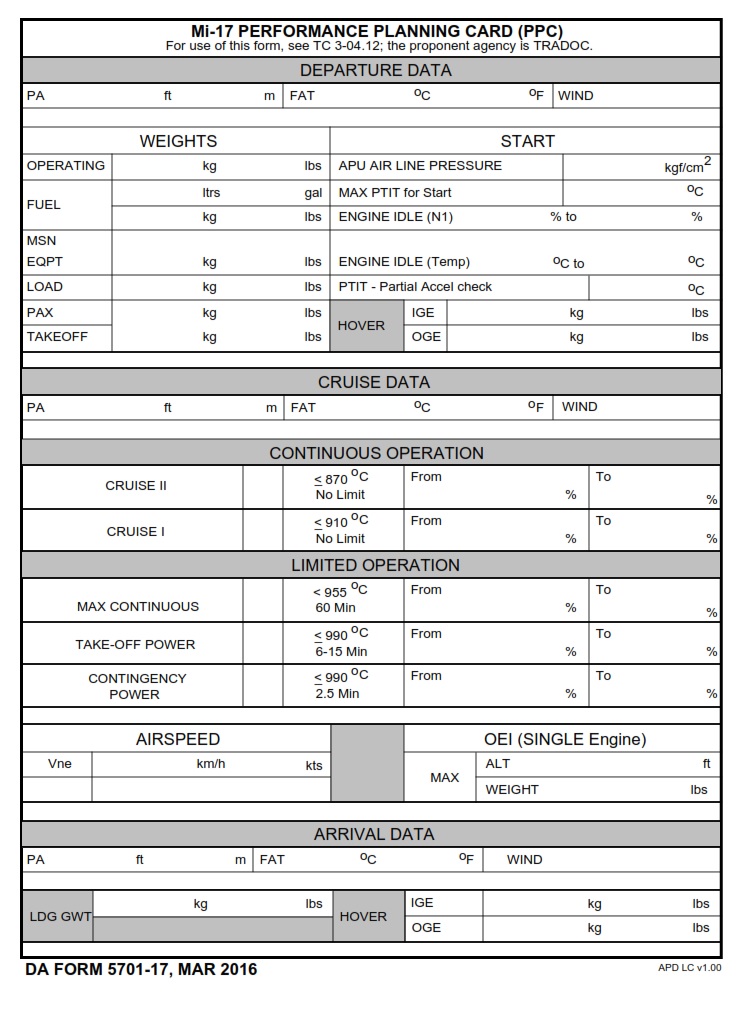Table of Contents
FREE-ONLINE-FORMS.COM – DA Form 5701-17 – MI-17 Performance Planning Card (PPC) – Are you ready to take to the skies? The MI-17 helicopter is a force to be reckoned with, and its performance planning card (PPC) is an essential tool for pilots and crew members. Whether you’re a seasoned aviator or just starting your journey in the world of aviation, understanding how to effectively use the DA Form 5701-17 PPC can make all the difference in your mission success. In this article, we’ll dive into the details of this crucial document and explore everything from its purpose to how it can enhance flight performance. So buckle up, because we’re about to lift off into the world of MI-17 helicopters and uncover the power of their PPC!
Picture this: You’re soaring through the sky in a powerful MI-17 helicopter, surrounded by breathtaking views and embarking on a thrilling mission. As exhilarating as that may sound, every successful flight begins with careful planning and preparation. Enter the DA Form 5701-17 – MI-17 Performance Planning Card (PPC). This unique document serves as a pilot’s secret weapon, ensuring optimal performance during every flight.
Download DA Form 5701-17 – MI-17 Performance Planning Card (PPC)
| Form Number | DA Form 5701-17 |
| Form Title | MI-17 Performance Planning Card (PPC) |
| Edition Date | 3/1/2016 |
| File Size | 45 KB |
What is a DA Form 5701-17?
The DA Form 5701-17, also known as the MI-17 Performance Planning Card (PPC), is a crucial document for military aviation operations. This form contains vital information that ensures efficient performance and mission success. It serves as a comprehensive checklist to help pilots plan and monitor their missions effectively.
One of the key aspects of the DA Form 5701-17 is its ability to aid in load planning. The card provides details regarding weight limits, cargo distribution, and center of gravity calculations. By carefully following these guidelines, pilots can ensure that their aircraft remains within safe operating parameters throughout the flight.
Moreover, the DA Form 5701-17 plays a vital role in maintaining communication during complex missions involving multiple aircraft. The form includes designated slots for radio frequencies and navigational waypoints, facilitating seamless coordination between different units. This level of detailed planning helps minimize errors and enhances overall operational efficiency.
In summary, the importance of the DA Form 5701-17 cannot be overstated when it comes to military aviation operations involving MI-17 helicopters. From load planning to maintaining effective communication during missions, this document serves as an indispensable tool for ensuring smooth and successful operations in challenging environments.
Where Can I Find a DA Form 5701-17?
If you’re in the military or have any experience within the U.S. Department of Defense, you may be familiar with the importance of forms and documentation. One such form that holds significant relevance is the DA Form 5701-17, also known as the MI-17 Performance Planning Card (PPC). This form serves as a crucial tool for gathering mission-specific information and evaluating performance during flight operations involving MI-17 helicopters.
Now, where can you find this elusive DA Form 5701-17? The answer lies within your unit’s command. Each unit should have a supply office or department responsible for managing and distributing various forms used within their specific branch or field. If you require access to this form, contacting your superiors or reaching out to those in charge of supplies will often yield positive results.
Additionally, various websites offer downloadable copies of commonly used military forms like the DA Form 5701-17. The official Department of Defense website is an excellent place to start your search, as it provides convenient access to a plethora of official documents used across different branches of the military.
In conclusion, locating a DA Form 5701-17 requires communication with your unit’s supply department and exploration of reliable online sources such as official government websites. With determination and resourcefulness, obtaining this essential documentation shouldn’t pose much difficulty. Remember its significance when it comes to proper performance planning and evaluation in MI-17 helicopter operations – it plays a vital role in ensuring mission success and safety in the ever-demand
DA Form 5701-17 – MI-17 Performance Planning Card (PPC)
The DA Form 5701-17, also known as the MI-17 Performance Planning Card (PPC), plays a crucial role in military operations. This document serves as a planning tool for mission commanders and helicopter crew members, allowing them to assess the aircraft’s capabilities and limitations before embarking on a mission. It contains essential information such as weight restrictions, fuel consumption rates, takeoff and landing distances, and required crew qualifications. Armed with this knowledge, commanders can make informed decisions and ensure optimum safety and performance throughout their mission.
One noteworthy aspect of the MI-17 PPC is its flexibility. The form provides space to record specific details for up to five distinct missions or tasks. This feature allows crews to plan multiple operations in advance or adapt their plans quickly during dynamic situations. By including separate sections for each task, the PPC streamlines data documentation while maintaining clarity and orderliness.
Furthermore, the PPC has evolved over time to meet changing requirements effectively. Recent updates have incorporated fields related to human factors considerations, such as minimum rest periods between flights or duty limitations based on crew fatigue levels. These modifications underline the military’s unwavering commitment to ensuring personnel safety while maximizing operational efficiency.
In conclusion, the DA Form 5701-17 – MI-17 Performance Planning Card is an invaluable tool that assists mission commanders inefficient decision-making processes by providing comprehensive information regarding an aircraft’s performance capabilities and limitations.
